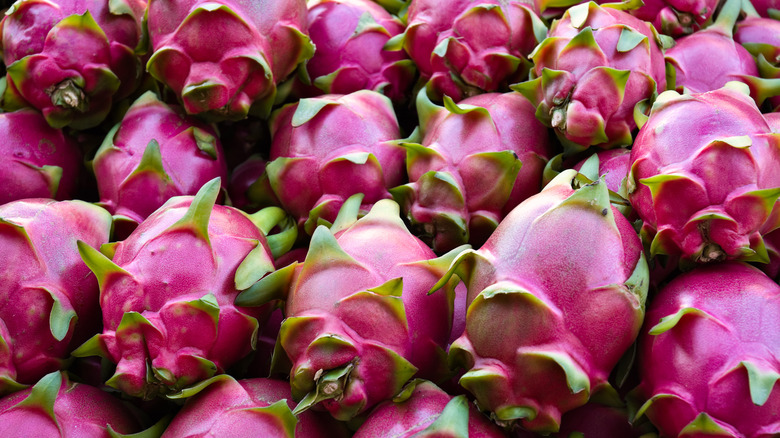Mistakes To Avoid When Growing Dragon Fruit Plants
Dragon fruit is a wonderful exotic treat grown from a tropical cactus. It has hot pink and green –- or neon yellow -– spiky scales that resemble the drawings of mythical dragons from ancient Chinese dynasties. Once you cut into it, you'll see that its flesh is striking white with small black edible seeds. Given the right conditions, dragon fruit plants can easily be grown either from seeds or from cuttings, especially in containers. As with anything else, though, there are certain mistakes you need to avoid. And like with other container gardening, most errors are made with regard to pot size, watering, and vertical training.
Because dragon fruit are tropical plants, they grow best in zones 10-12. Any cooler climates than that will run significant frost risk, that will damage if not kill the cactus entirely, so a greenhouse or other indoor accommodation would be required. Their soil should be well-draining with a bit of sandy texture to it, making container gardening ideal because the soil can be precisely mixed and kept slightly acidic. Containers are also great places to grow dragon fruit because they can be outfitted with stakes or trellises to properly train the climbing cactus upward to produce the best blooms and bounty.
Plan for space, proper watering, and upward mobility
The first mistake gardeners make when planting dragon fruit is not selecting a big enough pot. A large terracotta planter holding 25 gallons or more is not out of the question, as it can house multiple cuttings around a center pole trellis stake without the mature plants crowding each other out or overly competing for nutrients. Fill the pot with a good blend of soil, sand, and a small amount of high-phosphorus fertilizer, and let the cactus grow into the space rather than trying to constantly repot into containers big enough to hold it.
Terracotta planters are a great choice because they drain well. A dragon fruit does grow on a cactus, so it doesn't require an abundance of water. However, as a tropical cactus, it requires more water than traditional desert varieties. About an inch a week should suffice, but before you water, make sure the soil several inches down is indeed dry or root rot will form.
Finally, be sure to train your dragon fruit cactus upward to the top of your stake before allowing it to cascade downward, and prune all surplus offshoots as soon as they sprout -– clipping them cleanly at the base without damaging the primary stalk -– so they don't detract resources. A simple ribbon, twine, or zip tie can be used to secure the cactus vertically. If you're gentle, the stalk should prove flexible enough that it won't break and will follow your guidance.

